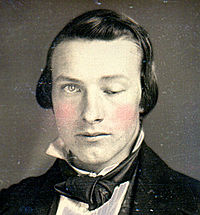
Photo from wikipedia
Background Neurogenic dysphagia is common and has no definitive treatment. We assessed whether pharyngeal electrical stimulation (PES) is associated with reduced dysphagia. Methods The PHAryngeal electrical stimulation for treatment of… Click to show full abstract
Background Neurogenic dysphagia is common and has no definitive treatment. We assessed whether pharyngeal electrical stimulation (PES) is associated with reduced dysphagia. Methods The PHAryngeal electrical stimulation for treatment of neurogenic Dysphagia European Registry (PHADER) was a prospective single-arm observational cohort study. Participants were recruited with neurogenic dysphagia (comprising five groups – stroke not needing ventilation; stroke needing ventilation; ventilation acquired; traumatic brain injury; other neurological causes). PES was administered once daily for three days. The primary outcome was the validated dysphagia severity rating scale (DSRS, score best-worst 0–12) at 3 months. Findings Of 255 enrolled patients from 14 centres in Austria, Germany and UK, 10 failed screening. At baseline, mean (standard deviation) or median [interquartile range]: age 68 (14) years, male 71%, DSRS 11·4 (1·7), time from onset to treatment 32 [44] days; age, time and DSRS differed between diagnostic groups. Insertion of PES catheters was successfully inserted in 239/245 (98%) participants, and was typically easy taking 11·8 min. 9 participants withdrew before the end of treatment. DSRS improved significantly in all dysphagia groups, difference in means (95% confidence intervals, CI) from 0 to 3 months: stroke (n = 79) –6·7 (–7·8, –5·5), ventilated stroke (n = 98) –6·5 (–7·6, –5·5); ventilation acquired (n = 35) –6·6 (–8·4, –4·8); traumatic brain injury (n = 24) -4·5 (–6·6, –2·4). The results for DSRS were mirrored for instrumentally assessed penetration aspiration scale scores. DSRS improved in both supratentorial and infratentorial stroke, with no difference between them (p = 0·32). In previously ventilated participants with tracheotomy, DSRS improved more in participants who could be decannulated (n = 66) –7·5 (–8·6, –6·5) versus not decannulated (n = 33) –2·1 (–3·2, –1·0) (p<0·001). 74 serious adverse events (SAE) occurred in 60 participants with pneumonia (9·2%) the most frequent SAE. Interpretation In patients with neurogenic dysphagia, PES was safe and associated with reduced measures of dysphagia and penetration/aspiration. Funding Phagenesis Ltd.
Journal Title: EClinicalMedicine
Year Published: 2020
Link to full text (if available)
Share on Social Media: Sign Up to like & get
recommendations!